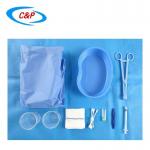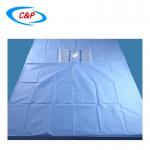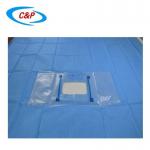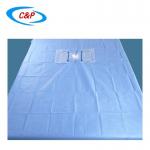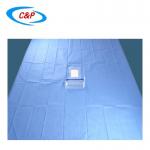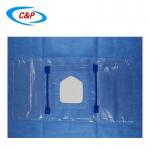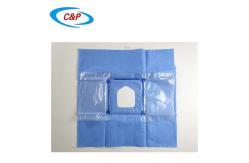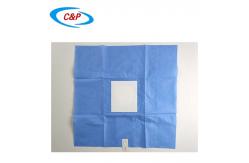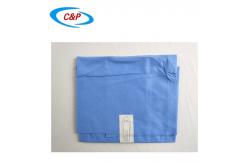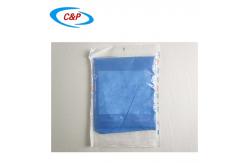Product Description:
Ophthalmic surgical drapes are designed specifically for use in eye
surgery and provide a sterile and secure environment for the
procedure. They are made from high-quality materials that are
resistant to fluids and tears, ensuring that the surgical field
remains clean and sterile throughout the procedure.
Ophthalmic surgical drapes are designed to meet the specific needs
of ophthalmic procedures, providing a sterile environment, clear
visibility, and easy instrument access for the surgeon. The
features mentioned above work together to ensure a successful and
safe ophthalmic surgery by maintaining sterility and enabling
precise surgical techniques. It is important to follow manufacturer
instructions and guidelines for proper use and disposal of
ophthalmic surgical drape.
Technical Parameters:
| Product Category | Ophthalmic Surgical Drape |
| Size | 60x60cm or as your request |
| Sample | Freight Collected |
| Material | SMS, PP, PE, Spunlace Non-woven Fabric |
| Application | Hospital And Clinic |
| Certificate | CE&ISO13485 |
| Efficiency | Allows for quick and efficient setup before a procedure |
| Feature | Soft, Procedure, Convenient, Waterproof |
| Sterility | Individually packaged in sterile bags |
| Infection Control | Key component of standard infection control practices |
Pictures:
Features:
- Product Name: Ophthalmic Surgical Drape
- Efficiency: Allows for quick and efficient setup before a procedure
- Certificate: CE&ISO13485
- OEM/ODM: Available
- Infection Control: Key component of standard infection control
practices
The Ophthalmic Surgical Drape is designed to provide a
comprehensive solution for maintaining sterility during
angiographic procedures. Its key features include:
1. Disposable: The ophthalmic surgical drape is single-use and
disposable to prevent cross-contamination between patients.
2. Sterility: The ophthalmic surgical drape must be sterilized
before use to ensure that it is free from bacteria and other
pathogens that could cause infection.
3. Waterproof: The ophthalmic surgical drape is made from a
waterproof material to protect the patient's eyes from spillage or
leakage of fluids during the procedure.
4. Size and Configuration: Ophthalmic surgical drapes come in
various sizes and configurations to accommodate different procedure
sites and patient positions.
5. Comfort: Ophthalmic surgical drapes are designed to be flexible
and comfortable for the patient, reducing the risk of discomfort or
irritation during procedures.
6. Customizable: Ophthalmic surgical drapes are available in
various sizes and shapes to fit the specific needs of different
procedures. Some drapes also have cutouts for surgeons' eyes.
7. Easy to Use: Ophthalmic surgical drapes are designed to be easy
to use, making them a convenient option for eye examinations,
surgeries, and other procedures.
Applications:
Ophthalmic surgical drapes are specifically designed for procedures
performed in ophthalmology, which involves surgeries related to the
eyes and their surrounding structures. These drapes are used to
create a sterile field and provide a barrier between the surgical
site and non-sterile surfaces, minimizing the risk of infection and
contamination during ophthalmic procedures.
Here are some common applications of ophthalmic surgical drapes:
1. Cataract Surgery: Ophthalmic surgical drapes are extensively
used in cataract surgeries, which involve removing the cloudy lens
from the eye and replacing it with an artificial intraocular lens
(IOL). The drapes are used to isolate the surgical site, including
the eyelids, lashes, and surrounding area, to maintain sterility
during the procedure.
2. Retinal Surgery: Retinal surgery is performed to treat various
conditions affecting the retina, such as retinal detachment or
macular degeneration. Ophthalmic surgical drapes are used to cover
and isolate the eye and surrounding structures to prevent
contamination and maintain a sterile environment during delicate
retinal procedures.
3. Glaucoma Surgery: Glaucoma surgeries aim to reduce intraocular
pressure to prevent or manage optic nerve damage caused by
glaucoma. Ophthalmic surgical drapes are utilized to create a
sterile field and cover the area around the eye, including the
eyelids and eyelashes, during glaucoma surgical procedures.
4. Corneal Transplantation: Ophthalmic surgical drapes are employed
in corneal transplantation surgeries, which involve replacing a
damaged or diseased cornea with a healthy donor cornea. The drapes
are used to isolate the eye and surrounding area and maintain
sterility during the intricate procedure.
5. Oculoplastic Surgery: Oculoplastic surgery involves procedures
related to the eyelids, tear ducts, and facial structures around
the eyes. Ophthalmic surgical drapes are utilized to cover and
isolate the surgical site, ensuring a sterile environment during
oculoplastic surgeries.
During ophthalmic procedures, the drapes are typically fenestrated
or have adhesive apertures to allow access to the surgical site
while providing a sterile barrier. They are made of fluid-resistant
materials to block the transmission of microorganisms and bodily
fluids.
It's important to note that ophthalmic surgical drapes are
specifically designed to meet the unique requirements of
ophthalmology procedures, ensuring a safe and sterile environment
for delicate eye surgeries.
Customization:
The customized service of ophthalmic surgical drapes involves
designing and manufacturing drapes that are specifically tailored
to meet the unique needs and preferences of individual surgeons or
surgical facilities. Here are some key aspects of customized
service for ophthalmic surgical drapes:
Material Customization:
1. Type of Material: The ophthalmic surgical drape can be made from different types of materials, such as
polyester, cotton, or a combination of both. The material can be
chosen based on the surgeon's preference and the specific
requirements of the procedure.
2. Thickness and Weight: The thickness and weight of the material
can also be customized to provide the desired level of protection
and comfort during the procedure.
3. Waterproofing: The ophthalmic surgical drape can be made waterproof to prevent fluids from seeping through
and contaminating the surgical field.
4. Breathability: The ophthalmic surgical drape can be made breathable to allow for better airflow and
temperature regulation during the procedure.
Size and Shape Customization:
1. Dimensions: The dimensions of the ophthalmic surgical drape can be customized to fit the patient's head and the surgical
site accurately.
2. Shape: The shape of the ophthalmic surgical drape can be customized to provide better access to the surgical
site and improve the ease of use for the surgical team.
Color and Design Customization:
1. Color: The color of the ophthalmic surgical drape can be customized to match the surgical facility's branding
or to provide better visual contrast during the procedure.
2. Design: The design of the ophthalmic surgical drape can be customized to include features such as pouches,
pockets, and tabs for holding surgical instruments and supplies.
Sterility and Packaging Customization:
1. Sterilization Method: The sterilization method used for the ophthalmic surgical drape can be customized based on the surgical facility's
preferences and requirements.
2.Packaging: The packaging of the ophthalmic surgical drape can be customized to include the surgical facility's branding
and to ensure that the drape remains sterile until it is ready to
be used.
Overall, customized service for ophthalmic surgical drapes allows
for a more personalized and efficient surgical experience by
providing drapes that are specifically designed to meet the unique
needs and preferences of individual surgeons and surgical
facilities.
Packing and Shipping:
Product Packaging:
The ophthalmic surgicalDrape is packaged in a sterile, sealed plastic bag to ensure
cleanliness and safety. The bag is labeled with the product name,
lot number, and expiration date.
Shipping:
The ophthalmic surgical Drape is shipped in a sturdy cardboard box to prevent damage during
transportation. The box is labeled with the product name, quantity,
and shipping address.
